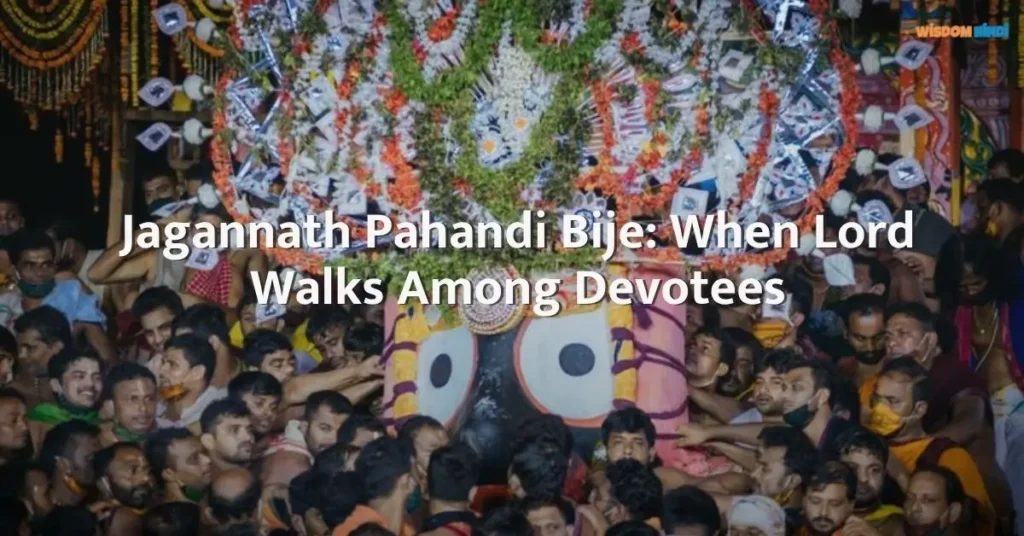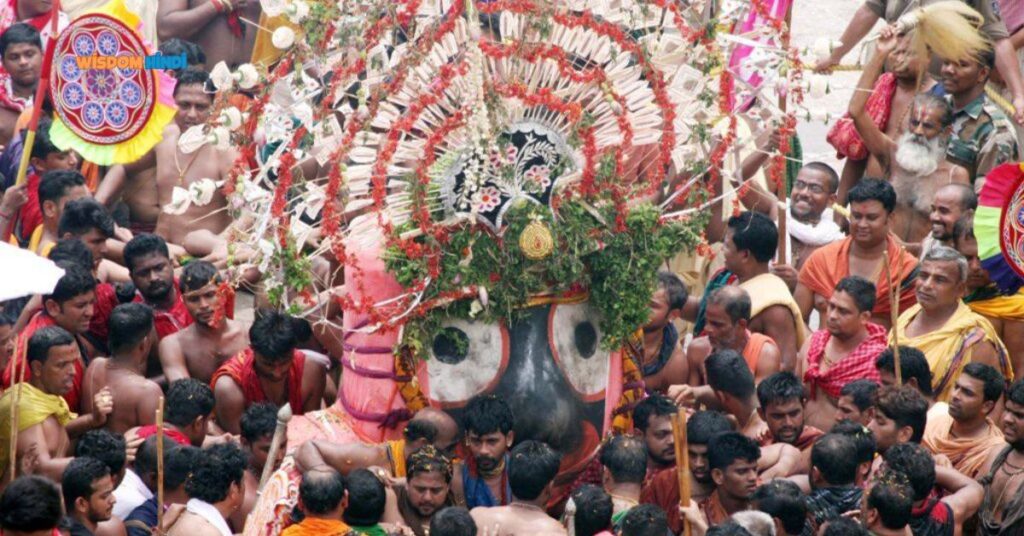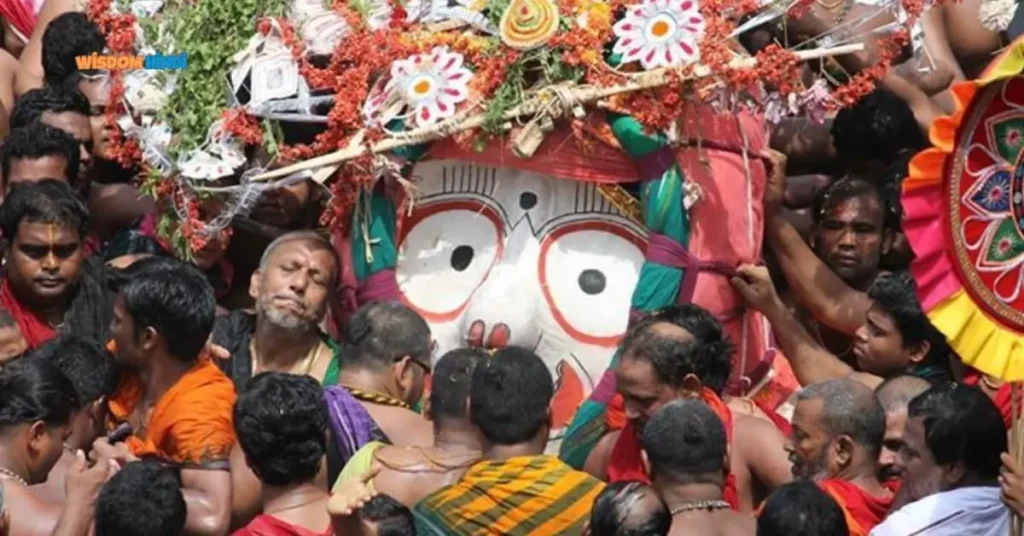
Jagannath Pahandi Bije Ritual: Lord Jagannath’s Rath Yatra is held annually in Puri. Many grand traditions and rituals are performed during this journey. One of these rituals is Jagannath Pahandi Bije. This ritual is the process of taking Lord Jagannath, his elder brother Balabhadra, and sister Subhadra to their chariots while in the sanctum sanctorum of the temple.
It is not only a religious traditional but also a spiritual festival that represents devotion and unity among devotees. Today’s discussion is based on the importance of Pahandi Bije, its process, misconceptions related to it, and other aspects.
Importance of Jagannath Pahandi Bije Ritual
Pahandi Bije means “Padamundanam”. It is a word derived from Sanskrit which means strolling at a balanced pace. Bije means the procession of the king or the gods. This ritual shows the human characteristics of Lord Jagannath which makes him similar to a common man. It strengthens the belief that God goes among his devotees and accepts their devotion and love.
Read More: The Mystery Behind Lord Jagannath’s Big Eyes Revealed
Pahandi Bije is the first phase of the Rath Yatra, in which devotees get the opportunity to see their idol. This ritual tells that God is accessible to everyone and he is equally available to people of every caste, religion, and community.
On the other hand, if we talk about the spiritual aspect of such a practice, Jagannath Pahandi Bije Ritual is a symbol of the soul’s journey of liberation. It symbolizes that just as God comes out of the temple and meets the devotees, similarly the human soul should free itself from the physical bonds and move towards God. This practice symbolizes that the path to reach God is full of devotion, dedication, and unity.

Process of Pahandi Bije
Jagannath Pahandi Bije Ritual is one such ritual that involves several steps and traditions. This ritual is carried out in these following steps-
Decoration of the deities– This practice begins with decorating the deity. Before Pahandi Bije, the idols of Lord Jagannath, Balabhadra, Subhadra, and Sudarshan Chakra are decorated with flowers, ornaments, and special clothes. The idols are specially decorated so that they are suitable for the Rath Yatra.
Dhadi Pahandi and Goti Pahandi– The Pahandi Bije ritual is performed in two ways- Dhadi Pahandi and Goti Pahandi. The Dhadi Pahandi ritual is performed when the deities are brought out of the temple towards the chariots. In this ritual, all four deities, Sudarshan, Balabhadra, Subhadra, and Jagannath, walk together in a line. Whereas the Goti Pahandi ritual is performed when deity return to the temple, in which the deity is taken one by one. Sudarshan Chakra moves first, then lord Balabhadra, Subhadra, and finally Lord Jagannath moves to the temple.
Senapat Lagi (Placing a pole behind idols)– The idols of Lord Jagannath and Balabhadra are heavy, so a wooden pole (sena) is placed behind them, and thick ropes are tied around their heads and waists. This process is called “Senapat Lagi”. The idols of Subhadra and Sudarshan are light, so they are carried in a lying position on the shoulders.
Music and Dance– During Jagannath Pahandi Bije Ritual, traditional musical instruments like Ghanta (bell), Kahali (trumpet) and Telingi Baja (drum) are played. Apart from this, Odissi dance and Sankirtan (collective bhajans) are also performed on this occasion, which creates a festive atmosphere. During this, devotees dance in enthusiasm with the proclamation of “Jai Jagannath” and “Hari Bol”.

Wearing the Tahiya– During Pahandi Bije, all the deities, including Lord Jagannath, are adorned with a Tahiya (crown) made of special flowers. This Tahiya is prepared by Raghav Das Math. Lord Jagannath’s Tahiya is called “Mayur Chandrika”. It is more than 7 feet high. Balabhadra’s Tahiya is also “Mayur Chandrika”, while Subhadra’s Tahiya is called “Pania”.
Journey to the chariots– To perform this ritual, the idols of the Lord are brought down from the Ratna Singhasan of the temple through 22 stairs. These stairs are called Baisi Pahacha. The idols are taken to the chariots. This journey is slow and lifeless, in which the servants shake the idols back and forth, which shows the reluctance of the Lord.
Traditions and customs Pabandi Bije
Many traditions are associated with Jagannath Pahandi Bije Ritualwhich makes it even more special. According to a tradition, devotees are allowed to taunt, slap, and criticize the deities during this time. This tradition shows the human image of Lord Jagannath who treats his devotees normally.
In another tradition, the chariots of the Lord are pulled by devotees during the Rath Yatra. This ritual symbolizes the destruction of sins and the receipt of blessings. Apart from this, the “Chhera Panhara” ritual is performed by the Gajapati King, in which he cleans the chariots, which gives the message of equality and humility.
Myths and stories related to the Pahandi Bije custom
Many stories and myths are related to Pahandi Bije and Rath Yatra. According to a ancient myth, Lord Jagannath comes out of the temple to meet his devotees as he cannot reject the love of his devotees. In another myth, it is said that Lord Jagannath visits his aunt’s house which is considered to be a symbol of his visit to his motherland.
Another popular myth is that the idols of the deity move by themselves during Pahandi Bije. In reality, it is the result of the hard work and speed of the sevaks. Another myth says that Rath Yatra is only for Hindus but it is open to all religions and communities.
Conclusion
Jagannath Pahandi Bije Ritual is an integral part of the Rath Yatra, It is a symbol of devotion, dedication, and unity. It depicts the love of the devotees towards their lords. Music, dance, and traditions make it a memorable experience. It is not only a religious tradition but also a cultural festival that presents the prime heritage of India to the world. Its basic meaning is that there are no restrictions in true devotion and God is available to all.
FAQ- Jagannath Pahandi Bije Ritual
What is the Dhadi Pahandi of Lord Jagannath?
The Pahandi Bije ritual is performed in two ways- Dhadi Pahandi and Goti Pahandi. The Dhadi Pahandi ritual is performed when the deities are brought out of the temple towards the chariots. In this ritual, all four deities (Sudarshana, Balabhadra, Subhadra, and Jagannath) come together in one.